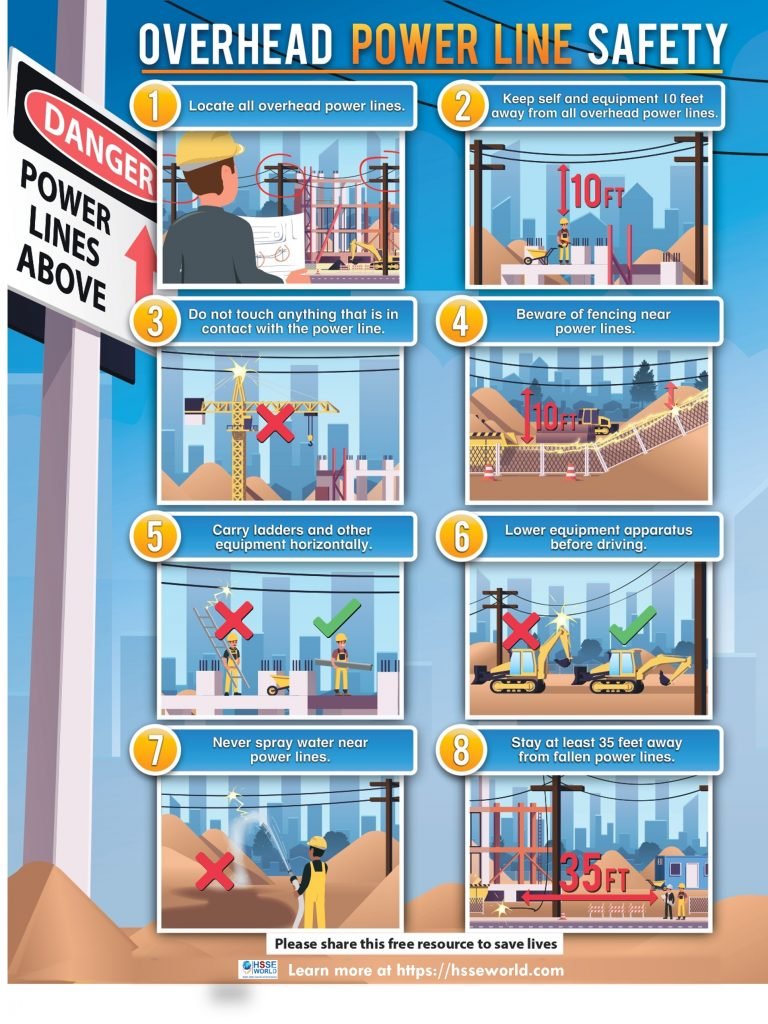Photo of the day: Overhead powerline safety
Between 2011 and 2018, 38% of all electrically related workplace fatalities were caused by overhead power lines. In the majority of these cases, fatalities occurred in occupations with little to no electrical safety training. So when you’re on a job site, remember to always look up, always – it can save your life.

If a vehicle or object contacts a power line or utility pole:
- Consider all lines to be live and dangerous
- Tell others not to approach the vehicle, downed lines, or anything that may be in contact with downed lines
- Warn others to stay at least 35 feet away
- Stay in place or inside your vehicle unless you see fire or smoke
- Call 911
In the event of fire or smoke:
- Do not touch the ground and vehicle at the same time
- Jump from the vehicle with your feet together
- Shuffle away and avoid lifting your feet
In 2016, 53% of all fatal electrical injuries occurred in the Construction industry. The Construction industry remained the leading source of fatal electrical injuries with 82, about three times the contribution of the second-highest source, Professional and Business Services. Learn how to work safely near power lines with these simple steps:
- Locate all overhead power lines
- Keep self and equipment 10 feet away from all overhead power lines
- Do not touch anything that is in contact with the power line
- Beware of fencing near power lines
- Carry ladders and other equipment horizontally
- Lower equipment apparatus before driving
- Never spray water near power lines
- Stay at least 35 feet away from fallen power lines
Safety Tips
- Look up before raising a ladder or pole to make sure that it will not come within 10 feet of any power lines.
- Use wooden or fiberglass ladders outdoors. Metal ladders conduct electricity.
- Contact your utility company immediately to report downed power lines outside your home.
- Always assume fallen power lines are energized. Stay at least ten feet away from a downed power line and any nearby objects it may be touching, such as a fence or a tree limb.
- Never touch a person who is in contact with a downed power line. Call 911 immediately.
- Downed power lines can carry an electric current strong enough to cause serious injury or even death. Electricity wants to move from a high voltage zone to a low voltage zone – and it could do that through your body.
(learn more at : video-working-safely-near-powerlines-safety-moment26/)
Downed Power Line Safety Tips
- If you see a downed power line, move away from it and anything touching it. The ground around power lines – up to 35 feet away – may be energized.
- You cannot tell whether or not a power line is energized just by looking at it. You should assume that all downed power lines are live.
- The proper way to move away from the power line is to shuffle away with small steps, keeping your feet together and on the ground at all times. This will minimize the potential for a strong electric shock.
- If you see someone who is in direct or indirect contact with the downed line, do not touch the person. You could become the next victim. Call emergency contact number for help.
- Do not attempt to move a downed power line or anything else in contact with it by using an object such as a broom or stick. Even non-conductive materials like wood or cloth can conduct electricity if even slightly wet.
- Be careful not to touch or step in water near where a downed power line is located.
- Do not drive over downed power lines.
- If your car comes in contact with a downed power line while you are inside, stay in the car. Honk your horn to summon help, but direct others to stay away from your car.
- If you must leave your car because it is on fire, jump out of the vehicle with both feet together and avoid contact with both the car and the ground at the same time. Shuffle away from the car.
(learn more:working-safely-near-overhead-electric-power-lines/).
Download the Infographic
More photos:
- Photo of the day: 10 Essential Safety Tips for Driving in Hot Weather Conditions
- Photo of the day: best workplace safety tips
- Photo of the day: The Importance of Stop Work Authority in Maintaining Workplace Safety
- Photo of the day: Tomorrow’s Reward for Working Safely Today: Cultivating a Culture of Safety
- Photo of the day: Preventing slips and trips at work
- Photo of the day: Learn the DRSABCD action Plan
- Working with Electricity Electrical Accidents Guide for Electrical Workers
- Photo of the day: Hearing Protection Device Selection
- Photo of the day: If An Earthquake Shakes You-Infographic free
- Fire Safety Posters Free Download
- Photo of the day: First Aid for Electrical Burns-Infographic free
- Infographic: First Aid for Cuts and Scrapes free download
- Photo of The day: Work Safe with Lasers-Laser Safety free
- Photo of the day: Working Safely with chemicals and chemical Management
- Photo of the day: Safe work practices when using MEWPs ( updated)
- Photo of the day: Preventing Common Kitchen Hazards
- Photo of the day: Safe handling of Gas Cylinders and lecture bottles
- Photo of the day: Forklift Stability Triangle
- Photo of the day: Defective Tools Safe Work Practice
- Photo of the day: Lift With Your Legs Not With Your Back
- Photo of the day: First Aid for burns
- Photo of the day: The 7 Principles of HACCP
- Photo of the day: Working Safely with Suspended Loads
- Photo of the day: Heat Stroke First Aid and safety posters
- Photo of the day: Near-Miss Reporting and Posters
- Photo of the day: Ergonomic chair and office chair safety tips
- Photo of the day: Whole Body Vibration
- Photo of the day: Substation Safety Equipment
- Photo of the day: Bypassing Safety Controls Rules
- Photo of the day: Lightning Safety Tips
- Photo of the day: Overhead Power lines Clearance
- Photo of the day: Floor Marking
- Photo of the day: Types of Foot Protection
- Photo of the day: Types of Hand Protection
- Photo of the day: Lockout and Tagout Safety
- Photo of the day: Fall Protection Plans
- Photo of the day: Flood Safety Tips
- Photo of the day: Read All Labels Work safe
- Photo of the day: Run Project safely with Crane Hand Signals
- Photo of the day: Flagman and Traffic control
- Photo of the day: Managing Risks of Exposure to Solvents in the workplace
- Photo of the day: Scissor Lift Safety
- Photo of the day: HSE Bulletin Board
- Photo of the day: Arc-Fault Circuit Interrupters (AFCI)
- Photo of the day: Safe use of ladders and step ladders
- Photo of the day: Concrete Truck Driver Hand Signals
- Photo of the day: Extension Cord Safety Tips
- Photo of the day: Protect your Head
- Photo of the day: choosing the right Anchorage
- Photo of the day: Work-Related Asthma
- Photo of the day: Top FIVE Heavy Equipment Construction Site Safety Tips
- Photo of the day: sun safety in the workplace
- Photo of the day: Cannabis and Impairment in the Workplace
- Photo of the day: Position for safety and comfort-Safety Tips
- Photo of the day: Generator Safety
- Photo of the day: Controlling COVID-19 in the Workplace-Physical Barriers
- Photo of the day: Manual Material handling
- Photo of the day: Personal Protective Equipment last resort
- Photo of the day: WHMIS 2015 – Pictograms
- Photo of the day: Indoor Air Quality
- Photo of the day: Noise in the affected workplace
- Photo of the day: Fatigue at Work
- Photo of the day: Don’t be Driven to Distraction
- Photo of the day: working in heat and Humidex Rating
- How to use Plate Clamps Safely: Safety Moment#34
- Photo of the day: Sitting at work
- Photo of the day: 5 ways to reduce the risk of Slipping and Tripping
- Photo of the day: Preventing the spread of contagious illness
- Photo of the day: Incident Investigations
- Photo of the day: 10 Scaffold Safety Essentials
- Photo of the day: Effective Health and Safety Committees
- Photo of the day: New worker Orientation & Safety Orientation checklist
- Photo of the day: Workplace Inspection
- Photo of the day: musculoskeletal disorders
- Photo of the day: Emergency preparedness in the workplace
- Photo of the day: Mental health in the workplace
- Photo of the day: Trenching Safety Tips That Can Save a Life
- Photo of the day: Dangerous Goods Classes
- Photo of the day: Safety Equipment for Confined Spaces
- Photo of the day: Tips to reduce Heat stress in the workplace
- Photo of the day: hierarchy of controls
- Your steps to chemical safety
- H2S Gas and how to handle its Emergency
- Photo of the day: Importance of Mock drill and Fire Action Emergency Procedure
- Photo of the day: Choosing the Right Face Mask and the difference between a respirator and face mask
- Photo of the day: Confined space safety Precautions
- Breath Safely: The Proper Use of Respiratory Protection
- Photo of the day: Electric shock survival
- Photo of the day: Chemical Spill Emergency Response
- Photo of the day: Construction Site fire Safety
- Photo of the day: Confined Space rescue
- Photo of the day: Conveyors Safety Tips
- Photo of the day: 5 Essential outcomes of an effective leadership survey process



